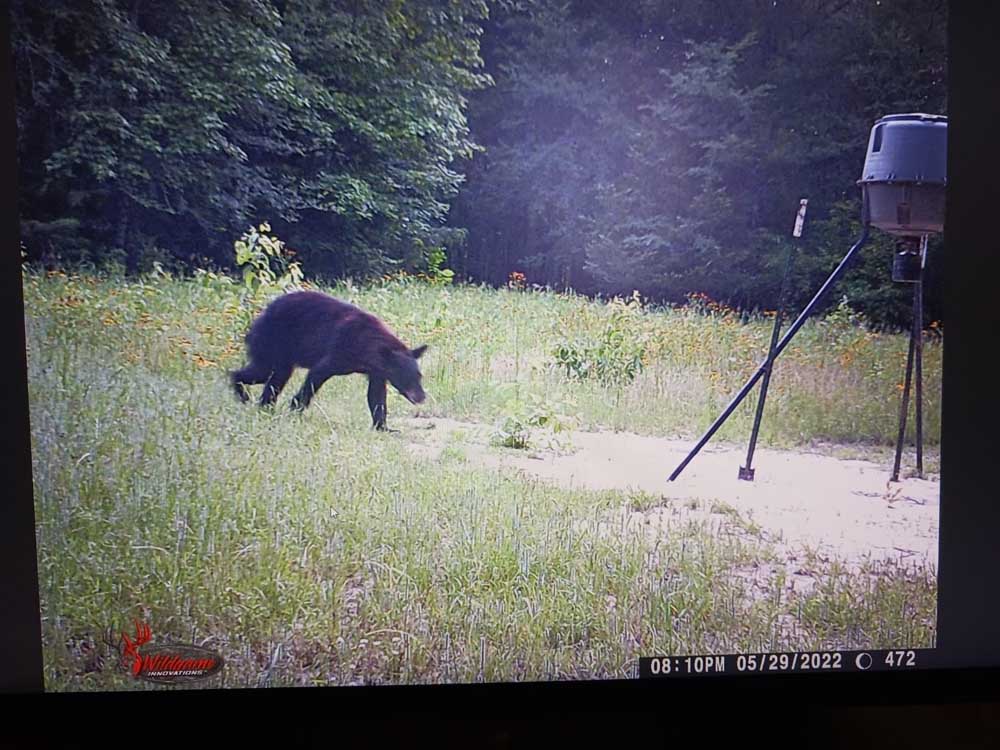Grin And Bear It: Black bear sightings have become a near-yearly occurrence in East Texas
Published 11:25 pm Thursday, August 18, 2022

- A black bear was spotted by a game camera visiting a deer feeder in Red River County earlier this summer.
When settlers first came to eastern Texas, they found the old-growth forests teeming with wild turkeys, deer, bobwhite quail, cougars and black bear.
But with the harvest of that timber, subsistence hunting and changing land-use practices by the early to mid-1900s, they all disappeared or nearly. Since then, white-tailed deer have been successfully brought back to the pineywoods and efforts continue to return eastern wild turkey.
Restocking bobwhite quail has never been successful so they remain on the missing list for the most part, and restocking bear or cougars has never been a consideration. Although a bear has not reported being taken in East Texas since the 1950s, hunting them remained legal into the 1970s when they listed as a state threatened species.
Black bear sightings remain rare, but thanks to game cameras they happen primarily in border counties along the Red River in Northeast Texas and are believed to be young males kicked out of families by mature bears in Oklahoma and Arkansas.
It has been several years, but bears have also been spotted in Southeast Texas. Those most likely come from Louisiana where there have been recovery efforts to bring back the Louisiana subspecies. Those are the bears that historically were found in East Texas.
“What we know in terms of sightings is that we have had sightings for six of the past seven years. Since 2016 we have had sightings every year except 2017,” said Dave Holderman, Texas Parks and Wildlife Department non-game wildlife biologist for Northeast Texas. The most recent being earlier this year just in Red River County.
Holderman explained those are confirmed sightings, with most coming from Cass and Bowie counties. While many of the years biologists may only be able to confirm a single sighting, in three years there were five and another six.
Holderman said there are about 10 reports for every confirmation under the department’s identification rules.
“We have a strict protocol that requires either photographic or physical evidence like tracks, hair, tree barking or a carcass. We had a roadkill a couple of years ago,” he explained. About half of the sightings come from game cameras.
Holderman said the department is not saying other sightings are not real, but without actual evidence they are not recorded.
The bears typically show up early in the summer. That timing, along with the game camera evidence, indicates they are probably young males.
“That is the breeding season for black bears. Personally, I feel it is related to that. I think if you look at black bear behavior, strangely enough they are matriarchal. A mother bear will tolerate a young female in her range, and eventually the young female will set up a home range next to her mother’s,” Holderman said.
In contrast he said the young males will leave their mother’s care at about 2 years old and go in search of a mate. That is when some end up in Texas.
“They wander around for a month or so, and when they never smell another bear they probably go back to their source population,” Holderman noted.
The populations in both Arkansas and Oklahoma are the result of repopulation efforts in the Ouachita National Forest. Arkansas stocked 250 bears initially trapped in Minnesota and Canada over a 10-year period. Those stockings have grown to a population estimated at over 3,000 in the western portion of the state. Some of those bears crossed into eastern Oklahoma, and today an equal number are estimated to live in that state.
Although Holderman said the adult female population generally stays close to home with a home range of about 5,000 acres compared to 20,000 for males, the population growth in those two states could some day be the basis for a population in Texas. However, it is probably going to require a significant event causing a food shortage that pushes some females south permanently.
If they do show up, there is no reason they would not stay and eventually build a viable population.
“I think they could populate any of the wooded or Post Oak Savannah country in this part of the state. It is not high-quality habitat, but it is suitable. They are omnivores, they will eat anything,” Holderman said.
Having grown up in Pennsylvania, which has black bears, and worked with bears in Alaska and New Mexico, he said the habitat in Northeast Texas is good enough to support bears.
“We have extensive oak forests and all kinds of soft mast. There are other things that are attractors, but food has to be one of the most important aspects,” the biologist said.
But it will not happen overnight.
“I think it will happen eventually here. I think it will happen in the next 25 years,” Holderman predicted.
Unlike cougars, black bears are protected in Texas. Shooting one could result in a $10,000 fine, plus civil restitution, jail time and loss of hunting privileges.
Anyone who spots a black bear in eastern Texas on their game camera or visibly is asked to call their local TPWD wildlife biologist or Holderman so they can try to verify as soon as possible. Holderman can be reached at 903-566-2161, ext. 209.






